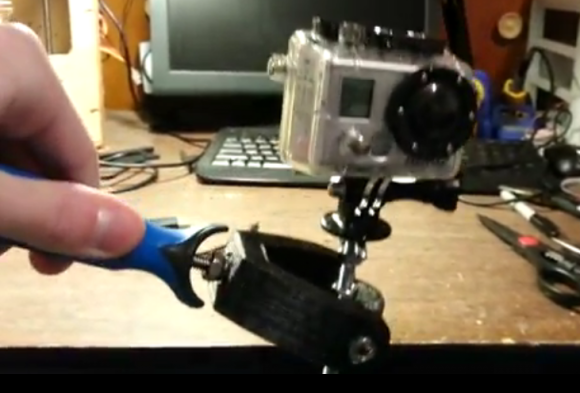[Ryan] wrote in to tell us about his partially 3D-printed steadycam mount on Instructables. In the video after the break, the camera does stay quite steady through some basic tests. The base is a paint roller handle, and the device works by using a long arm on the bottom with some weights to keep the camera upright. This handle is attached to the weights and camera through a 3-axis Gimbal system that allows the camera to stay relatively steady even if your hand isn’t. A full bill of materials and the needed STL files are provided.
Of course if you’re “old school” and like to use subtractive manufacturing methods, you can always check out this [camera stabilizer] from [Do-It-Yourself Gadgets]. The device works in a nearly identical manner, but the BOM seems to be: metal, screws, threaded rod. There are some cool animated GIFs of it in action on the site, or check out the video after the break.
As a “camera mount” bonus, check out this super easy [GoPro] (or any other small camera) clamp mount. Really clever.
[youtube http://www.youtube.com/watch?v=qeCgvwQO9I4&w=470&h=315%5D
[youtube http://www.youtube.com/watch?v=J0pbN4p51eA&w=470&h=315%5D
















Why is there never any sample footage taken from the mount with these sorts of things?
You mean like the footage in the second video?
Does anyone else think it looks like they were a lot more careful and deliberate when filming the stabilized footage than the footage without the stabilizer in the second video?
Exactly what I thought. They were practically running in the non-stabilized footage.
Yeah, this would be better if they ran 2 cameras at the same time. Also the footage would correlate better as a side-by-side.
Yeah, my bad. I’ve looked at a lot of home made stabilizers and it’s very rare that they include any sample footage. I rage commented before I had watched the second vid!
http://www.youtube.com/watch?v=UytSNlHw8J8
You know I’m still waiting to see someone make a camera stabilizer that doesn’t depend so much on gravity. Most of the things I’d need camera damping for are decidedly gravity-defying, and these things just plain don’t work when you’re dealing with a lot of acceleration.
What do you have in mind? I’m not an engineer, but it for something like a rocket it seems like you could just treat whatever direction the camera wants to go as down, whether it’s gravity or acceleration that’s causing the perceived force.
If you’re not depending on “downward” force I can’t think of any other approach besides having it track objects in its field of view, which seems like it’d be a lot harder. Like, *a lot*, depending on what kind of objects you’d be tracking.
The problems with this mount are that the gimbal has way too much friction and it should be dead on at the center-of-gravity.
I would love to see someone add a gyroscope on each axis for extra stabilization. Perhaps a trio of now worthless 5.25 inch Quantum Bigfoot drives (anyone remember those?) or 10,000 rpm or higher hard drives would do the trick.
Related:
http://littlegreatideas.com/stabilizer/diy/
i would have added another axis of rotation that would make the video smoother
I’m still down with this version. Works like a charm.
http://www.youtube.com/watch?v=JW6AWmqa8ZM